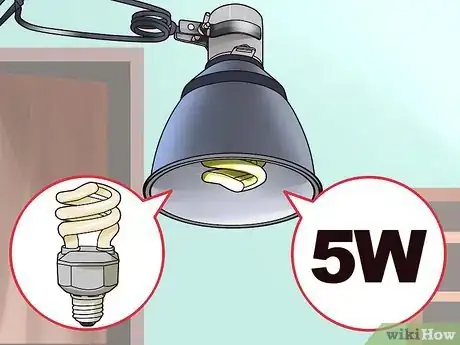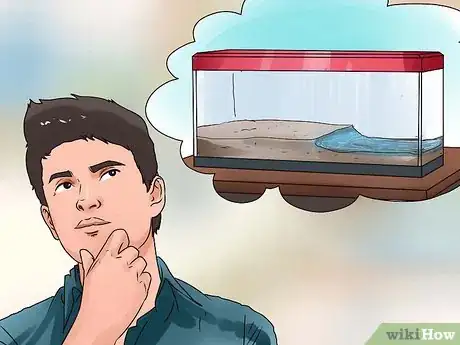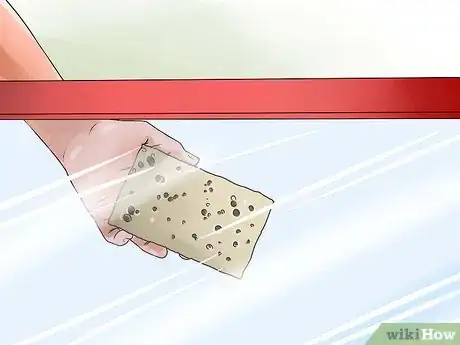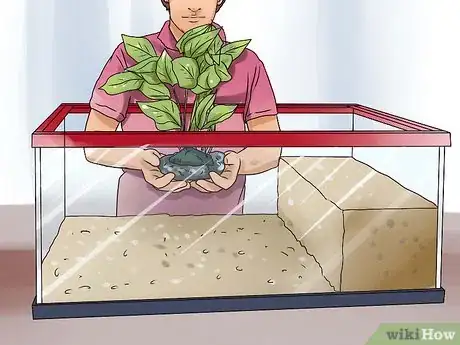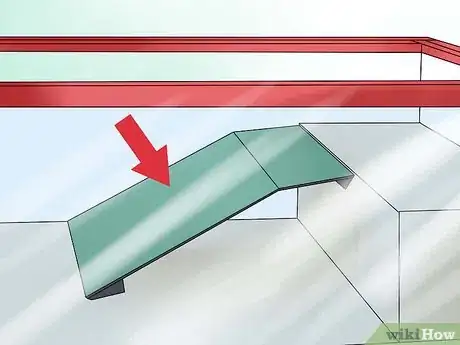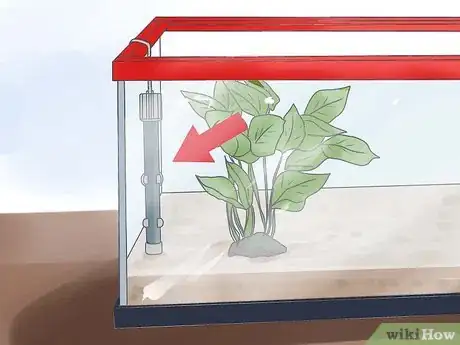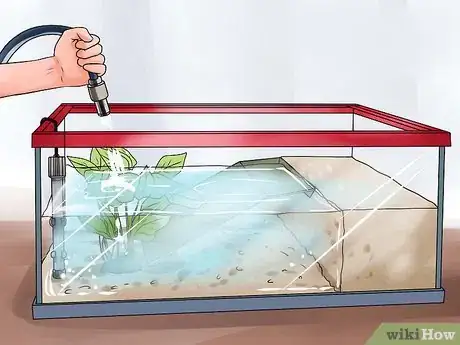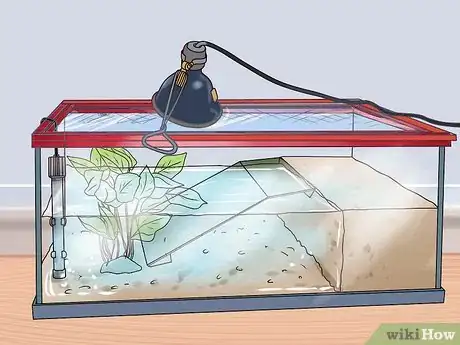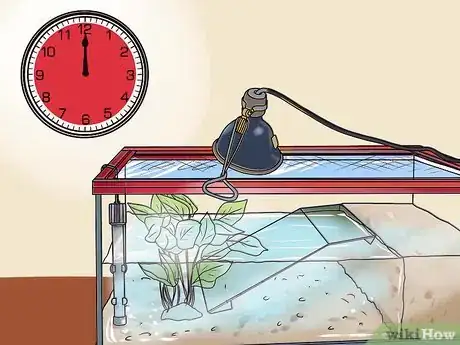This article was co-authored by Audra Barrios. Audra Barrios is a Marine Biologist and owner of Lick Your Eyeballs, a business offering experiemces, reptiles, supplies and plants. With over 15 years of experience, Audra specializes in reptiles and exotic animals, environmental education, marine biology, conservation issues, and animal husbandry. Audra earned a BASc in Marine Biology from the University of California, Santa Cruz, and studied Natural Sciences at the College of Marin. She is the founder and Executive Director of Things That Creep, a non-profit dedicated to herptile conservation through education. She has spent the last nine years working as a biologist at the California Academy of Sciences.
wikiHow marks an article as reader-approved once it receives enough positive feedback. In this case, 100% of readers who voted found the article helpful, earning it our reader-approved status.
This article has been viewed 137,667 times.
Turtles can make fun pets, but they do require a very specific habitat. This habitat includes a variety of necessities, such as water and a heat lamp, among other things. This article will help you to create a good habitat for your pet turtle.
Steps
Determining Your Turtle's Habitat Requirements
-
1Choose an enclosure for your turtle. Turtles need an enclosure that is appropriate for their size. The enclosure should be big enough that they have lots of room to swim, soak up heat from their heat bulb, and move about the enclosure in general.[1] [2]
- Do some research to see how big your turtle can get.
- A turtle whose carapace (the top shell) is eight inches in diameter will need to have a 75-gallon enclosure to itself, with an additional 20 gallons for each additional turtle.
- Use a fresh air screen cover to secure the top of your turtle's enclosure.
-
2Provide a heat lamp. Turtles are reptiles that require a heat source to regulate their body temperature, so you need to provide a heat lamp for this purpose. Install a thermometer to ensure the temperature in the basking area beneath the heat lamp's bulb stays between 80 and 85 degrees fahrenheit.[3]
- Heat lamps are UVA-spectrum lights, which should be used in the basking area, but your turtle also requires UVB light—install both types of light and put them on a timer to mimic patterns of the sun, adjusting for different seasons.
- Follow all the instructions for the installation of the heat lamp for safety.
- Set the UV lamp 12 inches (30 cm) from your animal.[4]
- Switch out the UV lamp every 6 months to a year, which is when they start to become ineffective.[5]
Advertisement -
3Determine how much water is needed in the tank. How much water the enclosure needs depends on whether your turtle is aquatic, semi-aquatic, or land-dwelling (tortoise).[6] Aquatic turtles should have a habitat that is 75% water, while semi-aquatic turtles should have an enclosure that is 50% water. Tortoises are land-dwelling, but they still need water for soaking—25% of the habitat can be water, provided it is very shallow, as tortoises can drown.[7]
- Be sure to research the species of turtle or tortoise you have to find out the specific habitat requirements for water.
- You'll need a water heater to regulate the temperature of the water to 78 °F (25.6 °C), though the temperature may vary slightly between species.[8]
- You'll also need a filter to keep your turtle's water clean.
- A dissolvable sulfa block will treat water and help keep your turtle healthy and disease-free.
- Non-chlorinated water is best for your tank.[9]
-
4Decide on the plants and basking surfaces you want to use. Plants may be desirable to keep the habitat looking natural and give the turtle some security. Basking surfaces can be purchased at pet stores. These may include manufactured ramps that the turtle can climb onto from out of the water or driftwood or rocks gathered from outside.[10]
- You may use artificial or real plants, but some turtles may attempt to eat fake plants. If this happens, the artificial plants should be swapped for real plants, provided the plants you choose are not poisonous to the species of turtle you have.
- Be sure the rocks and/or driftwood are clean and dry before placing them into the enclosure.
- Substrate—gravel or sand—is not necessary and may make cleaning the enclosure more difficult.
Setting Up Your Turtle Habitat
-
1Clean your enclosure. Whether the enclosure you have decided to use is new or used, you should ensure it is clean. Use an aquarium-safe sponge (available at pet stores) to clean the cage using pure water only.[11]
- Do not use any chemicals to wash the enclosure.
- Avoid abrasive cleaning pads because they may scratch glass, allowing for and algae contamination.
-
2Add any plants you choose to use. Like substrate, plants are not necessary for the enclosure. However, if you intend to use plants in the enclosure—whether real or artificial—set them up after substrate, if used. Live plants in the water may boost oxygen levels for the turtle while he or she is in the water.[12]
- Be sure that any plants you choose are not poisonous to the species of turtle you have, and replace the artificial plants with real ones if the turtle tries to eat them.
-
3Install the ramp. Install the turtle ramp or "turtle dock" to the basking area at this point. This may be a ramp purchased at a pet store or rocks or some driftwood positioned to allow a basking area outside the water.
- Keep in mind that the basking area will be directly under the heat lamp, so position it according to where you want the heat lamp to be installed.[13]
-
4Add the water heater, filter, and sulfa block. Before adding the water, install the water heater according to the instructions. Next, assemble and install the water filtration system. Finally, add your dissolvable sulfa block, which will condition the water and help keep your turtle healthy.[14]
- Be sure the water heater is fully submerged once you add the water.
- Use a filtration system that is meant to handle double the capacity of your aquarium to help with the efficiency of the filter.
-
5Add the water. Once you have completed the above steps, add the water to the enclosure and activate the water heater and filtration system. Avoid using chlorinated water or tap water. Allow the water to sit for 24 hours to allow water to dechlorinate. Dechlorination can also be achieved with a commercially available additive.[15]
- Vitamin supplements that can be added to the water can also help keep your turtle healthy.
-
6Install the fresh air screen lid and light(s). Place the fresh air screen lid on the top of the enclosure after completing the above steps. Above the fresh air screen, install the UVA and UVB lights. Some lights are available that are both UVA- and UVB-spectrum. Make sure the lights are on a timer to mimic daylight hours and positioned above the basking area you have created.[16]
- Remember to set up the lights safely to prevent accidents.
-
7Allow the aquarium to run for 24 hours and introduce your turtle(s). Before introducing the turtle(s), allow the aquarium filtration system and heater to run for 24 hours.[17] This also allows time for you to ensure the timer on your lights is working properly. After 24 hours, gently place your turtle(s) in the basking area and replace the fresh air lid and lights.
- The turtle should be left alone to explore his or her new home.
-
8Add lots of food options for the turtle to discover and eat. Turtles are omnivores, though some may be strictly vegan. Research your turtle's species to be sure what foods are appropriate. Greens, vegetables, fruits, flowers, worms, snails, insects, and cooked meats may be appropriate.[18]
- Some prepared foods are available at pet stores that will meet much of the turtle's dietary needs.
- Turtles may require a calcium supplement if their diet is not varied. Many are available at pet stores.
Warnings
- Substrate is not necessary for use in the habitat, and it may make cleaning a more arduous task. If you do want to use substrate, make sure it is big enough to discourage the turtle from ingesting it, as this can adversely affect your turtle's health.[19]⧼thumbs_response⧽
References
- ↑ Audra Barrios. Marine Biologist & Reptile Specialist. Expert Interview. 18 August 2020.
- ↑ http://www.drsfostersmith.com/pic/article.cfm?articleid=2230
- ↑ http://www.drsfostersmith.com/pic/article.cfm?articleid=2230
- ↑ Audra Barrios. Marine Biologist & Reptile Specialist. Expert Interview. 18 August 2020.
- ↑ Audra Barrios. Marine Biologist & Reptile Specialist. Expert Interview. 18 August 2020.
- ↑ Audra Barrios. Marine Biologist & Reptile Specialist. Expert Interview. 18 August 2020.
- ↑ http://www.petful.com/other-pets/how-create-turtle-habitat/
- ↑ http://www.drsfostersmith.com/pic/article.cfm?articleid=2230
- ↑ http://www.petful.com/other-pets/how-create-turtle-habitat/
- ↑ http://www.drsfostersmith.com/pic/article.cfm?articleid=2230
- ↑ http://turtletanksetup.com/
- ↑ http://turtletanksetup.com/
- ↑ Audra Barrios. Marine Biologist & Reptile Specialist. Expert Interview. 18 August 2020.
- ↑ http://turtletanksetup.com/
- ↑ http://turtletanksetup.com/
- ↑ http://turtletanksetup.com/
- ↑ http://www.aquaticcommunity.com/frogs-turtles/aquarium.php
- ↑ http://www.turtlepuddle.org/health/turtlefood.html
- ↑ http://www.drsfostersmith.com/pic/article.cfm?articleid=2230
About This Article
To make a turtle environment, start by choosing an enclosure large enough for your type of turtle, with a screen cover on top to let in fresh air. Next, install a heat lamp over the enclosure along with a thermometer so you can make sure the temperature stays between 80 and 85 degrees. Then, use things like plants, rocks, driftwood, and ramps from your local pet store to create surfaces for your turtle to rest on when it comes out of the water. Finally, install a water heater, filter, and sulfa block before adding water to the enclosure. For more tips from our Veterinary co-author, including how to dechlorinate tap water before using it in your turtle habitat, read on!


